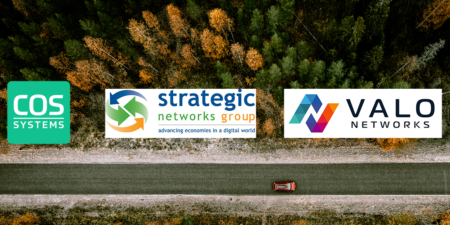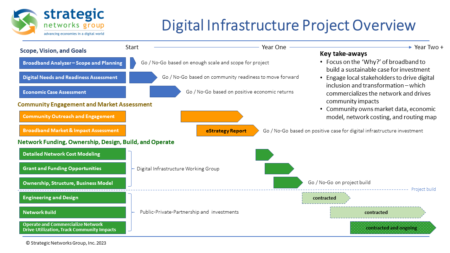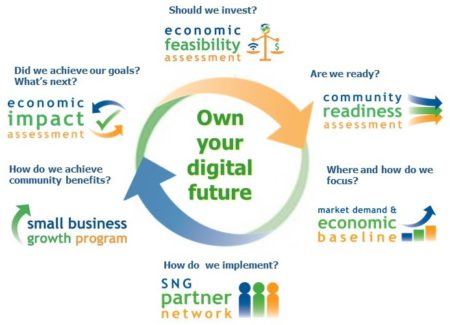Leaving No One Behind in an Increasingly Digital World
Joint White Paper on Options to Bridge Broadband Gaps in Unserved and Underserved Areas
 Abstract
Abstract
Ensuring that no one in your locality is left behind in an increasingly digital world means that everybody has access to reliable and affordable high-speed internet. This broadband connectivity has become essential infrastructure for localities. However, there are still areas where broadband services are non-existent (unserved) or inadequate (underserved).
After reading this whitepaper, you will be able to:
- Understand the options for addressing broadband gaps in your area
- Balance the options and engage in discussion with peers and community stakeholders to become a steward of your locality’s digital future
- Build consensus around the reasons and the path your locality should take in addressing your broadband and digital inclusion gaps
This whitepaper explores the challenges faced by localities (communities, regions, etc.) and presents four potential options to address their broadband gaps:
- Do nothing – the easy option, defer to incumbent networks. However, if those networks have not invested your broadband gaps, what has changed in their business case for your area to compel them to invest?
- Subsidize an ISP – traditionally considered a public-private partnership, but requires RFP management, risks broadband feasibility analysis paralysis, and has limited control over network coverage and timelines
- Become an ISP – which requires deep technical skills and takes on risk
- Develop a digital infrastructure public-private partnership – combine stakeholders leveraging their capabilities
After thorough evaluation, the digital infrastructure public-private partnership (DI-PPP) option emerges as the most recommended solution because it leverages the strengths of both public and private sectors to ensure affordable broadband access is available to all. Furthermore, a DI-PPP trades off the benefits of the other options. By taking an active role a locality can right-size the project in terms of capital expenditures and coverage, source partners in financing, construction and network operations (ISP), while also giving visibility into project milestones. Putting all of this together can be a challenge, therefore if existing partnerships should be engaged so that much of the time delay and risk can be reduced.
1. Introduction
In today’s digital age, access to reliable, affordable high-speed internet connectivity (broadband) has become a critical driver of progress across all sectors, particularly economic development, education, and healthcare. Broadband internet empowers individuals, businesses, and communities to communicate, access information, and participate in the global economy like never before. It enables e-commerce, remote work, online education, telemedicine, and social engagement, opening doors to new possibilities and improving quality of life.
Despite the transformative potential of broadband, many localities continue to face significant challenges in ensuring that all their residents and businesses have competitive and affordable broadband coverage. These areas are often called “unserved” and “underserved” because they lack reliable, high-speed internet services. The absence of digital infrastructure in these areas impedes their progress and exacerbates existing socioeconomic disparities.
1.1 Why do we care about broadband gaps?
The broadband gap is the discrepancy between regions with adequate broadband access and those without. It manifests in several ways:
Geographical Disparities: Unserved areas, typically located in rural or remote regions, have limited or no access to broadband due to the high costs associated with infrastructure deployment in sparsely populated areas or difficult terrain. Meanwhile, underserved areas may have some internet connectivity, but the speeds and reliability are inadequate for modern online practices.
Economic Disparity: The broadband gap can exacerbate existing disparities between affluent and disadvantaged communities. Lack of access to essential online services, educational and workforce training resources, and employment opportunities hinders the social mobility of underserved populations.
Digital Exclusion: In regions without reliable internet access, individuals and businesses face exclusion from the digital world. This can impede educational attainment, limit access to healthcare services, and hinder economic growth and participation in the digital economy.
Bringing digital infrastructure to all in your locality can alleviate economic pressures, create opportunities, and remove barriers to essential services. Given the extent to which these factors are part of everyday life, we want all who live in your locality to thrive.
1.2 Aim of the Whitepaper
By addressing the broadband gap, localities can unlock the full potential of their communities, ensure equal access to opportunities, and create a more inclusive and prosperous future for all. The path forward is not defined by a one-size fits all solution. This whitepaper aims to inspire informed consideration of the options available through actionable steps toward building a digitally inclusive and equitable society. Advantages and drawbacks of four unique options for bridging the broadband gaps are summarized in the following table. Further in-depth analysis of the particular of each proposed option provides detailed information to help decision-makers make better-informed choices about their locality’s digital future.
2. Options for Localities to Bridge Broadband Gaps
Addressing broadband gaps in unserved and underserved areas presents unique challenges for localities. This section explores four distinct options and examines their costs and benefits in order to help localities make better-informed decisions.
| Overview of Options in Addressing Broadband Gaps for Localities | |||
| Strategy | Cost | Projected Benefits | Expected Outcomes |
| 1. Do Nothing – leave unserved and underserved markets to private sector service providers. | For unserved and underserved areas:
|
No financial implications to locality because locality not getting involved. | Unserved and underserved areas will persist where there is not enough of a private sector business case to serve them
|
| 2. Subsidize Provider Business Case (traditional approach to public-private partnerships) | Subsidy (e.g., financial, rights of way, market exclusivity) by city to attract private sector partner investment in network | Service to designated unserved and underserved areas as part of partnership agreement | Subsidization of business case to a private sector partner
|
| 3. Become an internet service provider |
|
|
Operating as a competitive provider in an incumbent provider market (i.e., pre-existing providers serving area), which means that demand in unserved and underserved neighborhoods may not be enough to sustain a business case for a municipal ISP |
| 4. Digital Infrastructure Public-Private Partnership outsourcing operations and using an open access model for retail internet services | Resources to build a network and creation of a Broadband Authority / Utility, or Special Purpose Vehicle (SPV) | Internet service improvements and lower costs for bandwidth because open access enables competition and ubiquitous community access |
|
2.1 Analysis of Options to Bridge Broadband Gaps
With the goal of offering evidence-based recommendations for the most effective strategies for closing the broadband gap and fostering digital inclusion, the following sections provide comprehensive analysis and in-depth examination of each option for addressing broadband gaps in unserved and underserved areas, assessing its potential impact, feasibility, and sustainability in different contexts.
2.1.1 Do Nothing
Taking no action to address the broadband gap might seem like the easiest and least costly approach in the short term. However, this option comes with significant, potentially crippling long-term consequences to residents’ quality of life and the community’s prospects for economic growth.
Potential Benefits:
- Low cost and low political risk, initially
- Immediate Financial Savings: The locality decides not to invest in broadband infrastructure due to budget constraints, resulting in short-term financial savings for the local government.
- Avoiding Complexity: By choosing not to address the broadband gap, the county avoids involvement in broadband deployment’s complex regulatory and technological aspects.
Potential Drawbacks:
- Digital Divide Widening: The absence of broadband connectivity can exacerbate disparities between digitally connected and disconnected communities, leading to a widening gap in socioeconomic outcomes.
- Missed Economic Opportunities: Businesses in unserved and underserved areas will struggle to compete in the digital marketplace, leading to reduced economic development and investment.
- Educational Disadvantages: Students struggle to access online educational resources, limiting their academic performance and opportunities and encouraging families to consider relocation elsewhere.
- Healthcare Limitations: Telemedicine services are limited or unavailable, reducing access to healthcare, especially for those with mobility challenges or living in remote areas.
- Economic Stagnation: The lack of reliable broadband hinders economic growth, inhibiting job creation and discouraging new business investments and the relocation of remote and hybrid workers to the area.
2.1.2 Subsidize an ISP (traditional approach to public-private partnerships)
Subsidizing a single Internet Service Provider (ISP) using public funds is an option that aims to incentivize ISPs to extend their services to unserved and underserved areas. While this approach can lead to more rapid infrastructure deployment, it raises concerns about competition, market dominance, and sustainability.
Potential Benefits:
- Rapid Deployment: Subsidies can motivate ISPs to invest in broadband infrastructure in areas they might otherwise consider unprofitable, expediting the process of extending coverage. Providing financial incentives to ISPs to expand broadband access in unserved and underserved areas, can lead to a significant increase in coverage in a short period of time, rapidly bridging the broadband gap.
- Cost Sharing: Public funds can help offset the upfront costs of infrastructure development, lightening the financial burden on ISPs. Subsidies make it economically feasible for ISPs to invest in less profitable regions, thereby expanding broadband to previously unserved and underserved areas.
Potential Drawbacks:
- Lack of Competition and Innovation: Critics argue that subsidizing one or a few ISPs may lead to reduced competition, potentially resulting in higher prices, poor customer support, and less incentive for service improvements.
- Long-term Sustainability: Dependency on subsidies may not be economically viable in the long run, potentially leading to service disruptions if subsidies are withdrawn.
- Appropriate Use of Public Funds: Subsidizing the market power of one private entity may expedite broadband deployment, but in the long term may not be an efficient use of public funds because ongoing oversight is needed to:
- ensure that public funds are spent for their intended purpose and appropriately
- ensure that providers are not prioritizing only the most profitable neighborhoods, which is in their business interest
- regularly monitor the subsidized service provider’s value and quality of internet service in the absence of competitive market forces that self-regulate a market
2.1.3 Become an ISP
With this option, the locality itself takes on the role of an Internet Service Provider, aiming to address the broadband gap directly. While this approach offers local control, it has numerous challenges and complexities.
Potential Benefits:
- Full digital control of the network, including deployment and build-out priorities.
Potential Drawbacks
- Expertise and Resources Required: Becoming an ISP requires substantial technical expertise, managerial capabilities, and financial resources, which many localities might lack. Challenges in recruiting and retaining qualified personnel to operate its municipal broadband network is an increasingly high hurdle in a high-demand market for technical talent. Furthermore, the learning curve for dealing with various federal guidelines, rules, and regulations on operating a telecommunications network is a significant barrier
- Financial Strain: Establishing an ISP requires substantial upfront investment and ongoing operational costs, straining the locality’s financial resources.
- Infrastructure Investment: Building and maintaining broadband infrastructure demands significant capital investment, making it financially burdensome for local governments.
- Operational Costs: Operating as an ISP entails ongoing expenses for network maintenance, customer support, and upgrades, which can strain limited budgets.
- Competition with ISPs: localities might face difficulties competing with established private ISPs regarding service quality and coverage, which is a sustainability challenge.
- Legal Challenges: To prevent or restrict direct competition with private service providers, a number of States have enacted laws that prohibit or restrict municipalities in providing broadband services. Legal advice is needed to understand and how navigate such laws, which in the end may require structural separation of service provision from digital infrastructure[1].
2.1.4 Develop a Digital Infrastructure Public-Private Partnership (DI-PPP)
Forming a Digital Infrastructure Public-Private Partnership (DI-PPP) emerges as the recommended option for localities seeking to bridge their broadband gaps comprehensively, cost-effectively, and sustainably. PPPs involve collaboration and structural separation between network ownership (local Broadband Authority, or Special Purpose Vehicle), network operations (neutral operator), and network services (retail internet service delivery by private service providers).
The Digital Infrastructure PPP with structural separation enables an economic model where services generated from the infrastructure incentivize the neutral operator of that infrastructure to maintain and upgrade the network. The job of the Broadband Authority (network owner) is to make sure the operator meets the contractual requirements with the locality to maintain an open access, free market infrastructure in which private service providers can operate and compete. This works because the operator only makes money if there are service providers on the network and the community does not get involved in the free market – similar to how airport authorities are run. Localities (along with investors) can pursue grant funding and financing for the digital infrastructure investment and then outsource network build, maintenance, operations, and retail internet services.
Benefits of a Digital Infrastructure Public-Private Partnership:
- Shared Costs and Risks: In a Digital Infrastructure PPP, both parties share the financial burden and risks associated with broadband infrastructure development, making it a more sustainable approach.
- Leveraging Expertise: Private ISPs bring valuable technical knowledge, experience, and resources to the partnership, ensuring efficient deployment and operation.
- Scalability: Digital Infrastructure PPPs offer greater scalability, enabling broader coverage and reach in a shorter timeframe.
- Competition and Innovation: Collaboration with multiple private ISPs promotes healthy competition and drives innovation in service offerings and technologies.
- Sovereignty over Digital Infrastructure: Government maintaining control of infrastructure critical to its own operations and being able to better ensure its emergency and public safety responsibilities, as well as public good services such as ensuring education is available to all.
Potential Drawbacks:
- Up-front Community Engagement: Time and resources are required to engage residents and businesses in digital inclusion and transformation. However, ‘front-loading’ community engagement can build up-front the critical mass needed for sustainable deployment and is much more effective for planning than a “build it and they will come” approach. Also, up-front community engagement can better target and address digital inclusion gaps that are outside the business case of private sector internet service providers.
Project Management and Oversight: Hiring a trusted advisor and project management (on site and/or virtual) to ensure vendors contracted for the design, build, and electronics work in alignment with the locality’s needs to get to the right spots with the right timing, while de-risking the process. Project management and oversight is a cost to the locality, but also an investment into the locality’s stewardship role in its digital future.Digital Infrastructure Public-Private Partnership is emerging as the most viable and effective option for many localities seeking to bridge their broadband gaps. By leveraging the strengths of both public and private sectors, localities can create a strong collaborative environment that address many of the challenges incumbent in strategies that have either the community or ISPs singularly responsible for resolving broadband gaps. Furthermore, PPPs are emerging as a preferred funding model for various state and federal programs, working within existing state and federal legislation in network development and deployment.
Working together towards win-win solutions, public-private partners can craft solutions that enable equitable access to digital opportunities and that provide a sustainable digital platform for enhanced economic growth, education, healthcare, and social inclusion for all in the locality.
Best Practices for Successful PPPs:
- Clear Objectives and Agreements: Clearly outline the objectives, roles, responsibilities, and expected outcomes in a formal agreement between the public and private partners.
- Transparency and Accountability: Maintain transparency in project management, funds allocation, and decision-making processes to ensure public trust and accountability.
- Community Engagement: Involve local stakeholders, communities, and end-users in the planning and implementation phases to address their specific needs and concerns.
- Sustainability Planning: Consider long-term sustainability by exploring revenue-sharing models, future upgrade plans, and potential ongoing funding sources.
Addressing Potential Concerns:
- Potential Monopolization: Implement regulatory and operational measures to prevent monopolistic practices and ensure fair competition among private ISPs in the partnership.
- Equitable Access: Ensure the partnership aims to serve all communities, including those in remote or economically disadvantaged areas, to achieve equitable broadband access.
[1] Structural separation as with an airport authority that builds and operates airport infrastructure, reducing capital costs of airlines, but that does not compete with airlines and does not offer flight services.
3. Conclusion
Broadband connectivity infrastructure is essential for economic growth, education, healthcare, and social inclusion. Therefore, unserved and underserved areas and digital inclusion gaps present an increasingly pressing challenge for localities, and connecting as many people as possible must be a priority.
This whitepaper has explored four options to bridge the broadband gap:
- Do Nothing
- Subsidizing an ISP
- Becoming an ISP
- Public -Private Partnerships (PPP)
Each option was evaluated, considering its benefits, drawbacks, and potential implications. Public-Private Partnerships emerge as the most recommended solution. Digital Infrastructure PPPs foster collaboration between public and private sectors, leveraging shared costs, expertise, and resources. Successful PPPs offer scalability, healthy competition, and innovative solutions for equitable broadband access. Best practices include clear agreements, transparency, community engagement, and sustainability planning.
Benefits of Digital Infrastructure PPPs
- Leveraging Strengths: Properly developed PPPs bring together private ISPs and public entities, combining (financial) resources and technical expertise.
- Scalability: The PPP approach allows coordinated efforts to expand broadband infrastructure in rural and urban areas, leading to broader coverage.
- Competition and Innovation: Multiple private ISPs collaborating through the partnership foster healthy competition, leading to improved service offerings and innovative technologies.
- Leveraging Expertise: Private ISPs brought technical know-how and experience in operating networks, ensuring efficient deployment and improved service quality.
Drawbacks of Digital Infrastructure PPPs
- Negotiation Challenges: Establishing a successful PPP requires extensive negotiations between public and private entities, with potential disagreements on funding distribution and responsibilities.
- Ensuring Equitable Access: It is crucial to ensure that all communities within the region are served, including economically disadvantaged and remote areas, to achieve true digital inclusion.
In conclusion, the urgency of bridging the broadband gap to foster a digitally connected and equitable society is evident. Digital Infrastructure Public-Private Partnerships stand out as the most effective and sustainable approach, offering collaborative solutions to ensure widespread broadband access. Localities must carefully consider their unique needs, engage stakeholders, and implement well-defined Digital Infrastructure PPPs to achieve this vision. By embracing these recommendations and taking proactive steps, localities can drive positive change, empower their communities, and pave the way for a brighter, digitally inclusive future for all.
The collaborative approach offered by Digital Infrastructure PPPs allows localities to leverage the expertise and resources of both public and private sectors, creating a digitally inclusive environment that empowers communities and fosters socioeconomic development. Implementing PPPs will lead to enhanced educational opportunities, improved healthcare access, increased economic growth, and a more connected and equitable society for all residents.
4. Recommendations and Next Steps
This section provides actionable guidance for localities seeking to address the broadband gap and implement a Digital Infrastructure Public-Private Partnership (DI-PPP) as the preferred solution. It outlines key considerations, steps, and potential funding sources to ensure the successful implementation of the recommended approach. Strategic Networks Group, Valo Networks, and COS Systems have proven strategies, tools, and templates to help localities successfully undertake the efforts listed below.
4.1 Key Considerations for Establishing a Successful DI-PPP
Assess Local Broadband Needs: Conduct a thorough assessment of the locality’s broadband needs and existing infrastructure gaps. Identify the areas that are unserved or underserved with broadband. Prioritize regions with the greatest demand (current and potential) for broadband connectivity and assess the potential economic impacts and community benefits that can help make a case for public and private investment in digital infrastructure.
A key component of this is to collect local data on how individual households, organizations, and businesses are connected, using, and benefitting from the internet. This should include analysis of local competition and services, along with speed tests to gather factual data on the current options and actual speeds offered since publicly available data is rarely accurate on a local level.
SNG’s eCheckup broadband assessment tool and the Broadband Impact and Market Assessment collects this data on local broadband needs, necessary for making competitive cases for funding (public and private), engaging local stakeholders, and deciding where to build first.
Engage Stakeholders: Build collaborative relationships with stakeholders by showing them how they and the populations they represent will benefit, including local government officials, community representatives, private ISPs, educational institutions, healthcare providers, and businesses. Engage them in decision-making to ensure their needs and concerns are considered.
Establish a Strong Vision with Clear Objectives and Outcomes: Stakeholders must establish clear objectives and desired outcomes for the PPP, focusing on equitable broadband access, enhanced service quality, and improved digital opportunities for all residents.
Use Purpose-Built, High-Performance Platforms: Without proper tools, digital infrastructure is complex to operate. What you need are tools and software platforms that are built ground up to support this business model. These tools and software platforms include:
- COS Business Engine was launched in 2008 to automate the operations of digital infrastructure and Open Access Networks. As of 2023, Business Engine has been used to operate over 1 million subscribers on 200 Open Access networks worldwide.
- Strategic Networks Group and Broadband Catalysts have developed the BroadbandAnalyzer spatial analytics platform. Since 2015, this platform has been used to perform analysis of broadband availability, digital equity, and broadband funding across North America.
Governance and Regulatory Framework: Develop a clear governance and robust regulatory framework that encourages fair competition, prevents monopolistic practices, and ensures compliance with relevant laws and regulations.
Work with Network Operators and Service Providers: Operate and commercialize the digital infrastructure network to provide uncompromised connectivity in underserved communities by integrating technologies and optimizing markets – which is a key role that Valo Networks provides.
By understanding these recommendations and taking proactive steps to adapt them to their circumstances, localities can establish successful Digital Infrastructure Public-Private Partnerships to bridge their local broadband and digital inclusion gaps. The Digital Infrastructure Project Overview chart below shows how localities can move quickly and with ‘go / no-go’ decisions for local leaders cost-effectively to address their broadband gaps.

Steps to Implement a Digital Infrastructure PPP
The above project methodology shows how localities can bridge their broadband gaps comprehensively, cost-effectively, and sustainably. For information on how to pay for a digital infrastructure initiative, see: https://sngroup.com/investing-in-broadband-infrastructure/
Book a consultation with one of our experts today, or to tap into our pool of experts. 
If you want to learn more about digital infrastructure, public-private partnerships, digital inclusion, and how to get started, reach out to us at Strategic Networks Group.
For more information on what it takes to setup, operate, or commercialize digital infrastructure, don’t hesitate to reach out to us at Valo Networks.
For more information on what it takes to operate digital infrastructure, or an Open Access network, or to tap into our pool of service provider partners willing to participate, don’t hesitate to reach out to us at COS Systems.
For more information about developing a Digital Infrastructure Strategy for your locality, see: https://sngroup.com/digital-infrastructure-strategy-for-communities/
To book a consultation with an expert, please contact us:
Contact (1)
"*" indicates required fields



